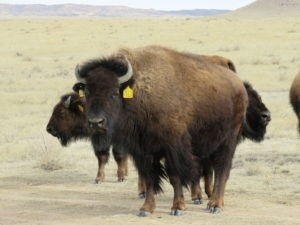Using any type of reproductive technology can be challenging.
March 26, 2018

In mid-March, eight bison — four calves and their mothers — were released on public lands in northern Colorado, bringing the total number of animals in the Laramie Foothills Bison Conservation Herd to 44. Included in the group was a 10-month-old calf known as IVF 1 — the first bison calf conceived using in vitro fertilization (IVF) at Colorado State University.
Jennifer Barfield, a reproductive physiologist with the Colorado State Animal Reproduction & Biotechnology Laboratory, said, “It’s a really good feeling to see a herd grow and to know that the animals from our research are going to have a real impact not only in our herd but as we produce animals in this herd and help support other conservation herds.”
The herd was established at Soapstone Prairie Natural Area and Red Mountain Open Space in November 2015 and is managed jointly by the city of Ft. Collins, Colo.; Larimer County, Colo., and Colorado State University.
“We are pleased to see the Laramie Foothills Bison Conservation Herd thriving and the public response so positive for this collaborative effort,” said Meegan Flenniken, planning and resource program manager for the Larimer County Department of Natural Resources.
IVF in bison. Using any type of reproductive technology can be challenging. “Just because we bring an egg into the lab and we fertilize it, it doesn’t mean that the result will be a baby bison,” Barfield said, noting that her research team had previously focused on using embryos produced in vivo — fertilized inside a bison and subsequently moved to a different animal.
For this project, researchers used eggs taken from bison in Yellowstone National Park and fertilized them in the lab with sperm from bulls with Yellowstone genetics.
Seven days after fertilization, the eggs were put through a rapid cooling process known as vitrification, similar to freezing. Scientists use vitrification to preserve the embryos and transfer them during breeding season, Colorado State explained.
The research team thawed a small number of embryos in 2016 and transferred them to nine bison cows.
The research team collects reproductive material from Yellowstone bison outside of the breeding season, which means the quality of the eggs may not be as good as collecting eggs during the breeding season when the animal is ready to get pregnant, according to the announcement.
Barfield said the result — the calf known as IVF 1 — was unexpected. “I didn’t have a lot of hopes for this particular embryo, because she didn’t look that great, but she defied the odds and survived,” she said.
Barfield said the team will transfer more IVF embryos later this year. She and the project partners hope to one day have 100 bison in the Laramie Foothills Bison Conservation Herd.
Dr. Mark Stetter, a wildlife veterinarian and dean of the Colorado State College of Veterinary Medicine & Biomedical Sciences, said the bison’s reintroduction is a “phenomenal” conservation story that demonstrates how cutting-edge research and collaborative relationships can really make a difference in helping nature.
Conservation efforts. The use of this reproductive technology in American bison also opens up another avenue for conservation efforts. Barfield’s lab at Colorado State has approximately 1,500 frozen embryos that could be used in a year -- or even in 100 years.
“That gives us the opportunity to access these Yellowstone genetics for a very long time,” Barfield said.
So, if something were to happen to the bison herd in Yellowstone National Park and their numbers dwindled, the frozen embryos could become quite valuable. It also means the risk of extinction is greatly decreased.
“Not only do the embryos carry the Yellowstone genetics, but they’re also brucellosis-free, which is really important for the Yellowstone bison,” Barfield said.
Brucellosis is an infectious disease that can cause abortions and plagues bison in the Greater Yellowstone Area. Its presence typically makes it challenging to move the bison beyond those geographic confines.
“Dr. Barfield’s innovative research is having a major impact across the country, from the Bronx Zoo in New York to the prairies of the West,” Stetter noted. “This unique partnership is really special and will make a difference for generations to come.”
You May Also Like


.png?width=300&auto=webp&quality=80&disable=upscale)
